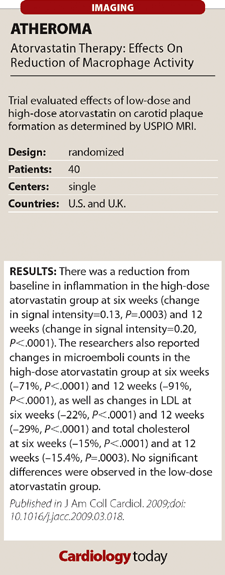ATHEROMA: High-dose atorvastatin associated with reduction in USPIO-defined inflammation
Aggressive lipid-lowering therapy over a three-month period was associated with a significant reduction in carotid lesion inflammation as defined by ultrasmall superparamagnetic iron oxide-enhanced MRI.
Researchers for the ATHEROMA study enrolled 40 patients with atherosclerotic carotid disease into the study and randomly assigned them to either atorvastatin 10 mg daily (n=20) or atorvastatin 80 mg daily (n=20). The researchers used ultrasmall superparamagnetic iron oxide-enhanced (USPIO) MRI to assess inflammatory activity and plaque formation in the patients’ carotid lesions. The primary endpoint was change in signal intensity on USPIO-enhanced MRI at six and 12 weeks.
According to the study results, a reduction in inflammation from baseline was observed in the high-dose atorvastatin group at both six weeks (change in signal intensity=0.13, P=.0003) and 12 weeks (change in signal intensity=0.20, P<.0001). The researchers also reported changes in microemboli counts in the high-dose atorvastatin group at six weeks (–71%, P<.0001) and 12 weeks (–91%, P<.0001), as well as changes in LDL at six weeks (–22%, P<.0001) and 12 weeks (–29%, P<.0001) and total cholesterol at six weeks (–15%, P<.0001) and at 12 weeks (–15.4%, P=.0003). No significant differences were observed in the low-dose atorvastatin group.
“This, to our knowledge, is the first study of a targeted MRI contrast agent used in humans to assess therapeutic response in an interventional drug trial,” the researchers wrote in their conclusion. “As validation continues, USPIO-enhanced MRI methodology may be a useful imaging biomarker for the screening and assessment of therapeutic response to antiinflammatory interventions in patients with carotid atherosclerotic lesions.”
In an accompanying editorial published in the Journal of the American College of Cardiology, several researchers cautioned against overstating the results of the ATHEROMA study.
“Although the current statin trial using noninvasive carotid USPIO-enhanced MRI is interesting and unique, further studies are required to determine the clinical applicability of this methodology for use as an end point in clinical trials,” the authors wrote. “The valuable ATHEROMA study adds further momentum to the importance of using diagnostic molecular imaging in the development of future cardiovascular therapies.” - by Eric Raible
For more information:
- Fayad Z. J Am Coll Cardiol. 2009;doi:10.1016/j.jacc.2009.03.021.
- Tang T. J Am Coll Cardiol. 2009;doi:10.1016/j.jacc.2009.03.018.

